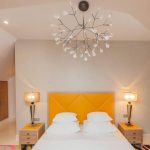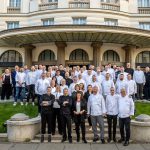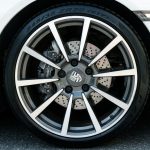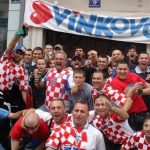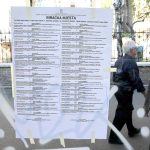December 3, 2019 – A closer look at the future ecovillage Blaca on Brac island.
The latest photos of the future ecovillage Blaca on Brac are truly breathtaking. Slobodna Dalmacija writes that the creator of the conceptual design of this ecovillage is Hrvoje Bota, a Bachelor of Architecture and permaculture designer, and also the director of the social enterprise “Održivo” from Split and Vice President of the Permaculture Association of Dalmatia.
In agreement with investors, Hrvoje Bota and the project team at Održivo have arranged everything needed for the eco-community using natural construction materials, energy systems from renewable energy sources, while enhancing and conserving biodiversity and ensuring a comfortable stay for guests.
“The project task was to build five family farms (OPG) on ten hectares of farmland. Given that this area is further away from existing settlements, we proposed the concept of a small eco-community, which is independent of the infrastructure network.
We wanted it to be self-sufficient and to meet all the needs for water, food and energy, and at the same time, we wanted to blend in all the scenery and the view that stretches from this steep terrain. There is a growing awareness in the world of using healthy materials and preserving a healthy environment, and this eco-community on Brac is also a response to climate change.
Here we are working specifically to combat climate change, increasing biodiversity and resilience of ecosystems,” emphasizes Hrvoje Bota.
In keeping with Bota’s life philosophy, everything Održivo does is focused on socially and environmentally conscious business and environmental design.
Bota’s life philosophy is also evident in this future ecovillage. The whole space is conceived as one production unit, consisting of several parts.
“In addition to five units, each of which has a residential and economic part, there is also a common area for socializing, a tavern, a court for bocce ball, a space for children to play, and various facilities in the open-air lounge.
All OPGs will cooperate in olive growing, sheep farming, viticulture, growing fruits in a polyculture orchard and vegetables in their own vegetable garden for those who will live there and visitors who come to the ecovillage. Aromatic Mediterranean herbs and honey will also be grown in the village. There will also be chickens that will be in mobile homes (the so-called Chicken tractor),” Bota adds.
Each OPG is designed for ten people, each cottage in the olive grove will have five rooms, and Robinson accommodation is planned renovated with stone, and glamping tents. There will be communal restrooms.
The land on which the ecovillage will be built is steep terrain, water washed away the soil, and the fires that burned on that part of the island contributed to the erosion.
How to regenerate the soil is one of the key questions that Hrvoje Bota answered through holistic management. He says the pioneer of such a smart management model is the globally renowned Savory Institute, whose methods have helped restore soil in many parts of the world.
“With holistic management, which means a combination of perennials and biomass, and with smart, controlled grazing, soil fertility is increased. We have a combination of durable trees, such as holm oak, black Dalmatian pine, we plant olives, carob, mulberries, cherries, almonds – everything must be drought resistant.
It is also important that the vineyard fits in the drywall, that the protection of the Dalmatian cultivated landscape is in place in the ecovillage. We have corridors to protect against wind, fire, erosion, and everything is designed according to the Keyline model, so anything planted follows the natural configuration of the terrain by contour lines,” Bota adds.
He further points out that the use of local and natural materials such as stone, which is not lacking on Brac, is envisaged to the greatest extent, followed by wood, lime, sheep’s wool, and hemp.
“Natural materials have a positive effect on the health and quality of housing; these are all breathable, non-allergenic materials. For example, the houses will be stone outside, the inside will be blocks of hemp, while wood will be used for the roof, as well as the windows and pergolas,” Bota said.
He adds that investors are interested in an independent energy model and the use of renewable energy sources, so the emphasis is on solar, low-wind wind energy, and biogas production from animal and vegetable waste.
Also, passive measures of solar design, i.e., natural cooling and the use of thermal mass, will maintain the optimum temperature in residential and commercial space.
There is no water supply in the area, so the goal is to collect as much rainwater as possible and store it in underground tanks.
“The eco village will have a common tank that will be filled from the large floodplain at the highest point, from where it will fill the tanks of residential and commercial buildings. They will also have smaller tanks along with objects to be filled from their roofs as well.
Furthermore, water will be collected in natural pools of biological and plant filter systems, and this water will also be used for irrigation. Gray water in households will also be purified and used,” explains Bota.
And when it comes to water supply and irrigation, mixed orchards and olive groves are designed according to the slope of the terrain so that their root systems absorb any excess rainwater or wastewater, thus preventing soil erosion and creating a resilient microclimate.
He also points out that the very increase in organic matter in the soil can be expected to significantly increase moisture retention, which will favor the development and survival of the crop.
“Each drop should be caught and retained, which is planned on several levels. Over time, as the system is established, it will affect the local microclimate and water will be a growing problem,” says Hrvoje Bota, pointing out that in designing and building such a system it is initially important to start designing the parts that are the most durable.
Thus, first, they must look at the climate, the configuration of the terrain, the water supply options, the road access, then the trees, buildings, fences, and soil, Bota concluded.
To read more about lifestyle in Croatia, follow TCN’s dedicated page.


